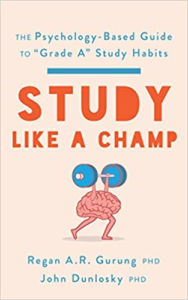I had the opportunity last week to connect with Dr. Regan  Gurung, Psychology Professor and Executive Director of the Center for Teaching & Learning here at OSU about his upcoming book Study Like a Champ: The Psychology-Based Guide to “Grade A” Study Habits. Coming in January from the American Psychological Association’s LifeTools Series, Study Like a Champ aims to equip students with tools and information to improve their approach to college-level learning. Regan collaborated with a former colleague from the University of Washington, Dr. John Dunlosky, combining their strengths from lab-based cognition research, college classroom research, and decades of university teaching experience.
Gurung, Psychology Professor and Executive Director of the Center for Teaching & Learning here at OSU about his upcoming book Study Like a Champ: The Psychology-Based Guide to “Grade A” Study Habits. Coming in January from the American Psychological Association’s LifeTools Series, Study Like a Champ aims to equip students with tools and information to improve their approach to college-level learning. Regan collaborated with a former colleague from the University of Washington, Dr. John Dunlosky, combining their strengths from lab-based cognition research, college classroom research, and decades of university teaching experience.
For Regan, that’s what feels particularly special about this book. In the field of cognitive science there is a lot of information available about effective studying and learning, but not much of it makes it into a format that is accessible for students who in their busyness wouldn’t have time to weed through dense scientific journal articles (my words, not Regan’s) or books written primarily for educators. With years of teaching experience, Regan is excited to bring specific strategies to students based on what he’s learned working with college students in the classroom. This practical classroom setting has prepared him to frame strategies in a way that students can use.
Two of the concepts discussed in “Study Like a Champ” are spaced practice and retrieval practice. Spaced practice refers to the act of spreading out learning/studying sessions over time to allow memory consolidation to take place, which is more effective than cramming. Retrieval practice is the technique of trying to recall information without reminders or visual cues. Instead of looking at something and feeling like you know it, you actually test yourself to see if you can recall that information without looking at it. Learning about spaced practice or retrieval practice is useful, but Regan says he wanted to make sure students knew how to do those things as well. Regan shared with me that he used to mention retrieval practice in his psychology classes, but now he goes a step further to ensure that students understand what he means and how to do that, and get to experience it through the course design. For example, students in his intro psych class get to practice information recall every class period.
According to Regan, the goal of this book is to “provide students with the latest cognitive science on how to learn effectively and efficiently, in a way that translates jargony science into practical information they can use immediately after reading.”
I like the idea of giving students more information about what effective studying looks like, backed-up by research and information from the field of psychology. That’s one of our primary goals in the Academic Success Center and we work on this through different programs (the Learning Corner, ALS 116, Academic Coaching, Supplemental Instruction). What excites me about this book is the conversations it invites.
Like Regan, I see possibilities for conversations about studying happening across campus. If students, faculty, and staff are better equipped with the language of effective study strategies, we can have more conversations about studying and integrate it into our work. Planning, note-taking, and learning happen beyond the classroom as well which makes information about how we learn relevant to everyone. Myths about learning styles and other learning practices are pervasive and the antidote in my mind is in this book and other sources that provide practical information on what works and what doesn’t.
When “Study Like a Champ” is released in January, I’ll be reading it and thinking of how to get this information in the hands of students. Maybe it’s new content for the Learning Corner, maybe it’s a student staff meeting on the topic of studying, or reviewing the orientation content from our OSU Welcome event. I’ve requested the OSU Libraries purchase this text once it releases and I offer an invitation here to each of you for further conversation about how to integrate these concepts into our work with students.

